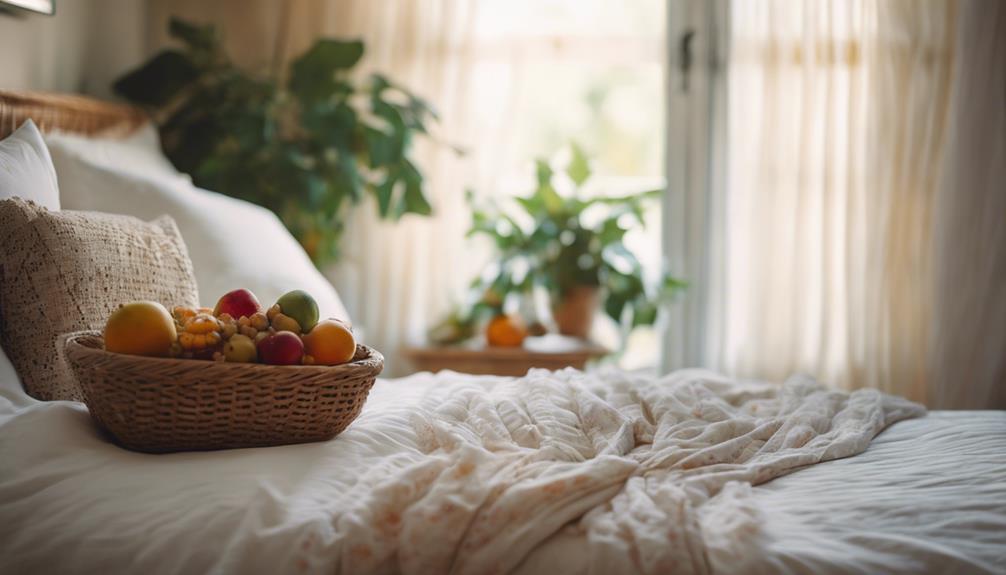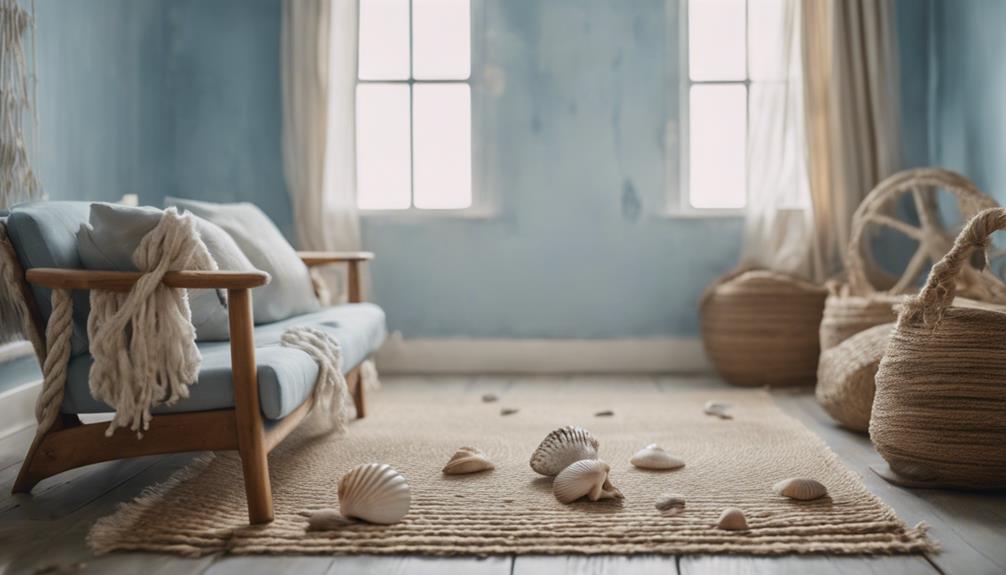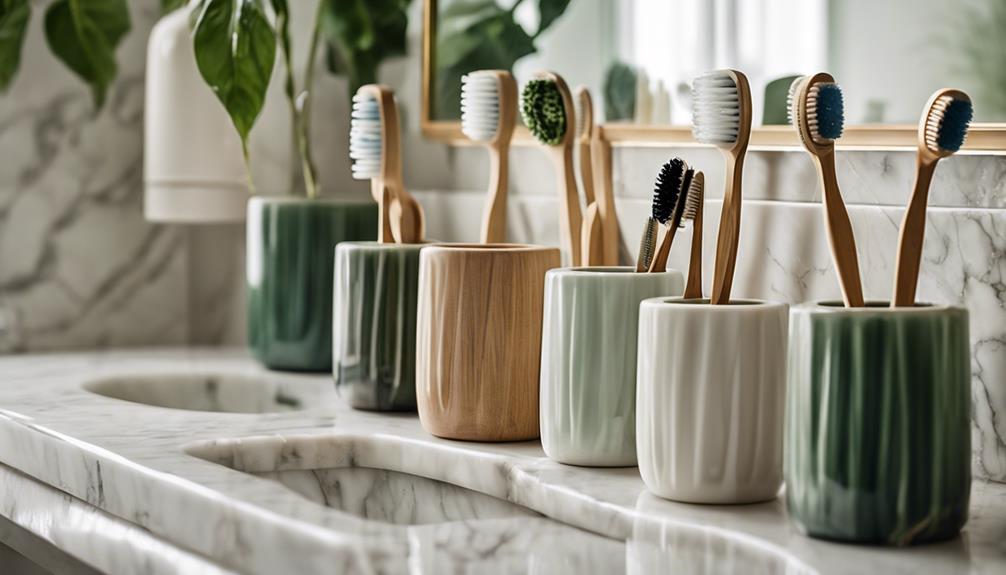You can completely transform your bedroom for late summer with some simple hacks. Start by swapping out heavy bedding for lightweight options in cheerful colors. Update your window treatments with airy, sheer curtains to maximize natural light. Declutter your space to promote serenity and invite calmness. Incorporate real plants for a fresh touch, and add seasonal flower arrangements for visual interest. Don't forget to layer textures for comfort and infuse your space with summer scents using candles or essential oils. Each of these simple changes can create the perfect sanctuary, and there's plenty more to explore!
Key Takeaways
- Embrace light bedding with breathable materials like cotton or linen to enhance airflow and promote relaxation during summer nights.
- Refresh your color palette with vibrant accents, mixing textures for visual depth and seasonal updates to pillows and throws.
- Update window treatments with lightweight, sheer curtains in soft summer colors to maximize natural light and create an airy feel.
- Declutter your space by removing unnecessary items and donating unused decor to foster a serene and minimalist environment.
Embrace Light Bedding
To beat the heat of late summer nights, embrace light bedding that keeps you cool and comfortable while you sleep. Switching to lightweight coverlet sets is essential for maintaining a breathable sleep environment. These sets regulate your body temperature, ensuring you don't wake up drenched in sweat.
Look for materials like cotton or linen, which naturally enhance breathability and create a cooler sleeping surface compared to heavier fabrics like flannel.
Opting for neutral bedding not only provides versatility but also allows you to easily invigorate your space with colorful accent pillows and throws when the mood strikes. This way, you can adapt your bedroom decor without much hassle.
Additionally, choose easy-to-wash materials for your bedding. This makes cleaning a breeze, so you can maintain a fresh and inviting atmosphere in your room.
Thankfully, retailers like Walmart offer budget-friendly options, giving you a range of styles and fabrics to suit your taste without breaking the bank.
Refresh Your Color Palette
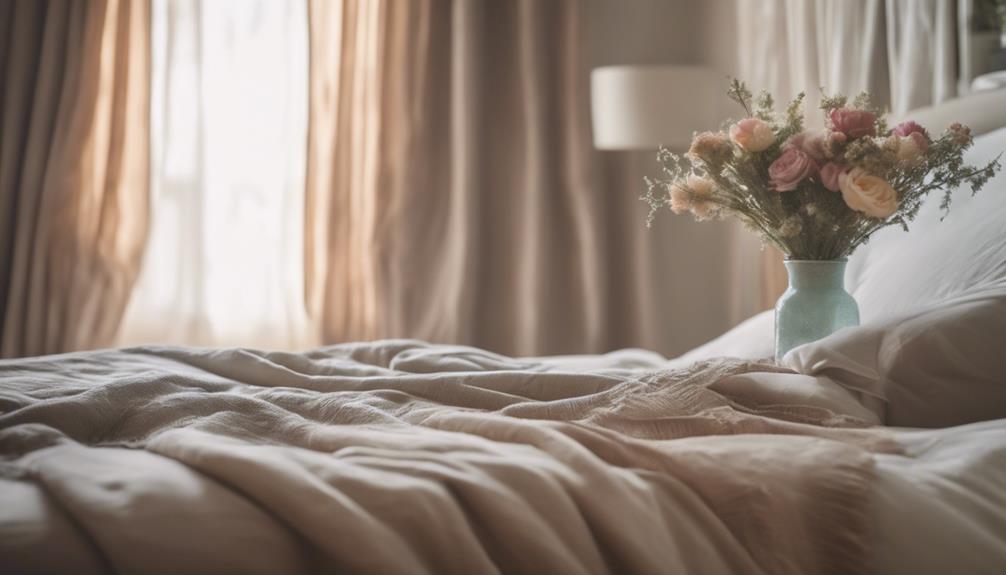
Revitalizing your color palette can instantly elevate your bedroom's summer vibe, making it feel bright and inviting. To refresh your color palette, consider incorporating fun colors like burnt yellow and mustard into your neutral decor. These vibrant hues can create a cheerful atmosphere, perfect for late summer.
You might also want to explore lighter shades reminiscent of sand and sea. These colors promote relaxation and enhance the overall ambiance of your space. Mixing textures is essential too; combine cotton coverlets with nubby accents like jute cording to add depth and interest.
Don't underestimate the impact of seasonal color changes. Introducing vibrant pillows and throw blankets can provide those much-needed pops of color while maintaining cohesiveness. Warm colors like gold will also align with summer themes, subtly enhancing your decor.
Update Window Treatments
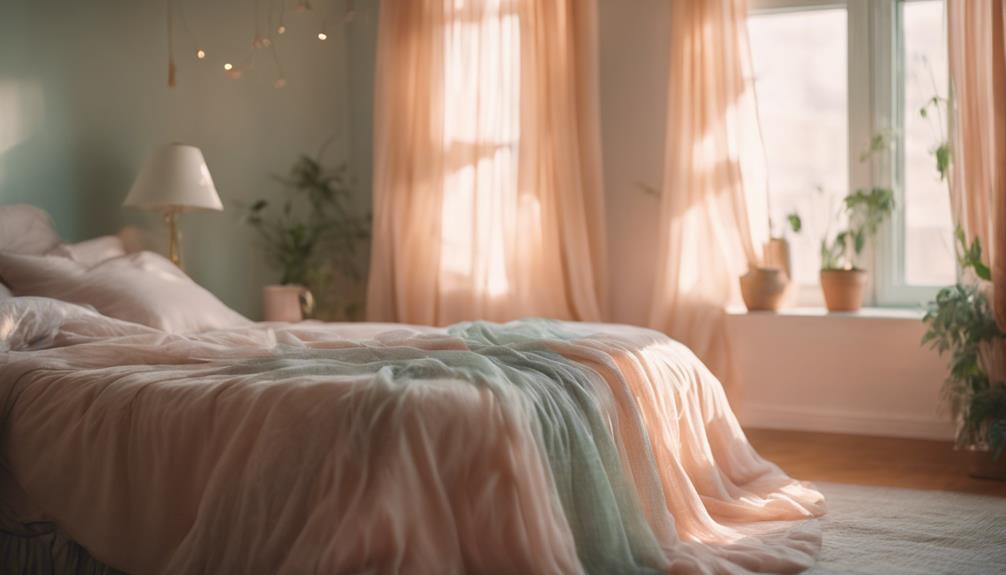
Updating your window treatments can instantly transform the feel of your bedroom, making it brighter and more inviting for late summer. Replace heavy thermal or blackout curtains with lightweight, sheer alternatives to maximize natural light and create an airy atmosphere. Opt for light-filtering fabrics that maintain privacy while enhancing brightness, ensuring your bedroom feels fresh and breezy.
Consider soft, summery colors for your curtains to add a cheerful touch that complements your seasonal decor. Choose lengths that extend to the floor for an elegant appearance, making the space feel larger and more inviting. Regularly wash and maintain your window treatments to keep them looking fresh and to eliminate dust, contributing to a clean and healthy environment.
| Treatment Type | Benefits | Color Suggestions |
|---|---|---|
| Sheer Curtains | Maximizes natural light | Soft white, pale blue |
| Light-filtering Fabrics | Enhances brightness | Light yellow, pastel green |
| Floor-length Curtains | Adds elegance, spacious feel | Soft lavender, light coral |
Declutter for Serenity
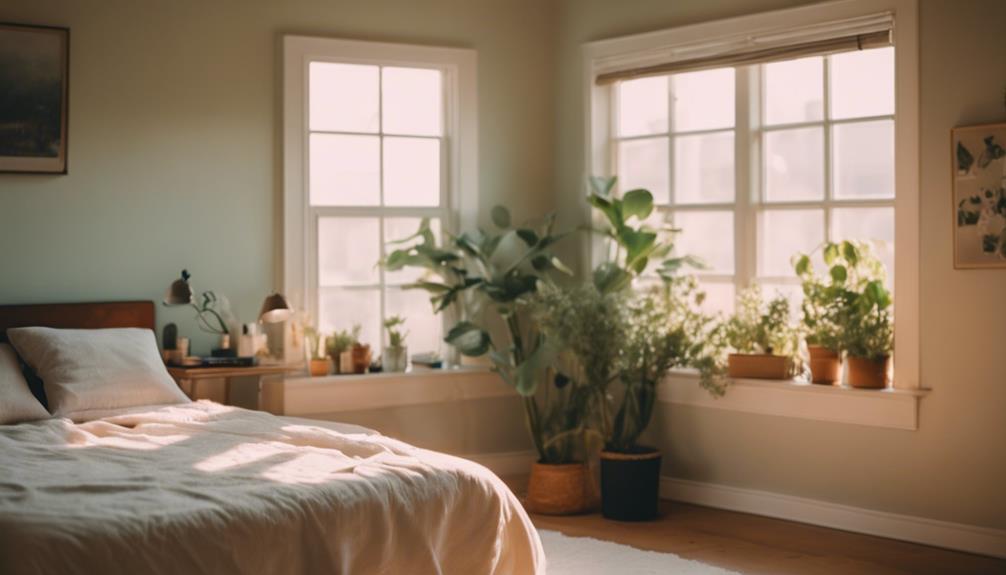
To create a serene bedroom for late summer, start by clearing surface clutter from your dresser and nightstands.
Consider donating unused items and embracing a minimalist approach to enhance your space.
This simple decluttering process can greatly boost your comfort and mood.
Clear Surface Clutter
How can clearing surface clutter transform your bedroom into a serene retreat?
When you clear surface clutter from your dressers and nightstands, you create a visually appealing and tranquil environment. This simple act can greatly reduce stress and promote relaxation, making your bedroom a true sanctuary.
Start by removing unnecessary items that accumulate on your surfaces. Heavy winter bedding should be stored away, allowing for a lighter, airy feel. Embracing a minimalistic approach not only simplifies your decor but also makes maintenance easier. Limit decorative items to a few meaningful pieces that bring you joy, enhancing the calming effect of the space.
A clean and organized environment fosters a sense of control and well-being, positively impacting your overall living experience. You'll find that a serene atmosphere encourages better rest and rejuvenation.
Donate Unused Items
Donating unused items not only clears your space but also fosters a sense of calm and purpose in your bedroom. By taking the time to assess what you truly need, you can create a serene environment that promotes relaxation and focus. Studies show that a decluttered space can reduce stress, making your bedroom a peaceful retreat.
Consider donating items such as:
- Gently used clothing you haven't worn in over a year
- Home decor pieces that no longer inspire you
When you donate unused items, you're not just making space; you're giving those items a chance to bring joy to someone else. Many local charities and organizations appreciate your contributions, and it's an easy way to make a positive impact on your community.
Embrace Minimalist Approach
Embracing a minimalist approach transforms your bedroom into a serene sanctuary that fosters relaxation and focus. By decluttering, you create an environment that promotes mental clarity and reduces stress. Studies show that a clean, organized room can greatly improve your overall well-being. When you embrace a minimalist approach, you'll notice how much lighter and more inviting your space feels.
Start by implementing smart storage solutions. For instance, using plastic bins for under-bed storage can hide clutter and make a big difference in how spacious your room appears. Additionally, regularly donating or discarding unused items not only freshens up your bedroom but also provides a sense of accomplishment and clarity.
As you simplify your surroundings, you'll likely find that your productivity and creativity increase. A tidy space allows for clearer thinking and less distraction, making it easier to unwind at the end of the day.
Incorporate Natural Greenery
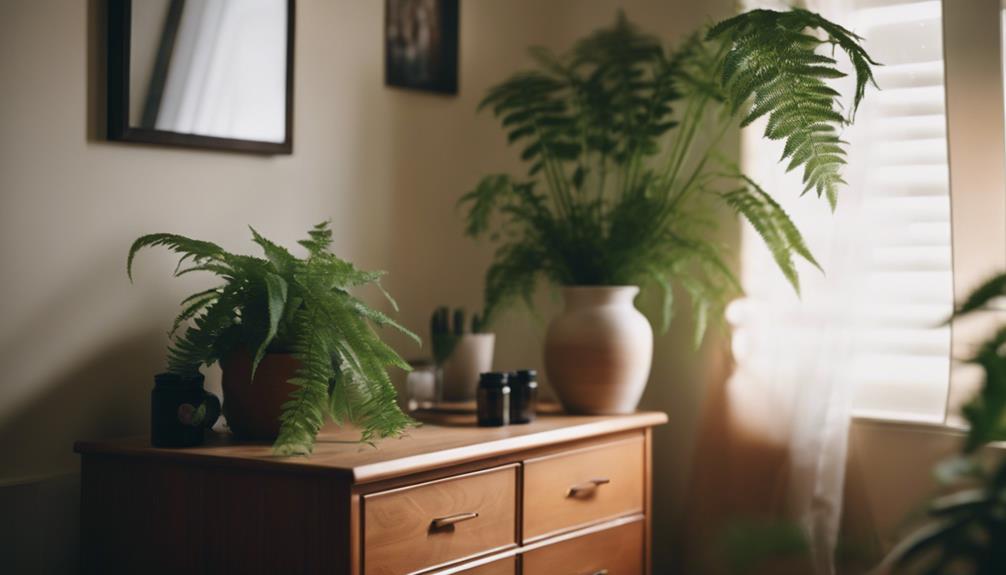
Incorporating natural greenery into your bedroom can transform the space and improve your well-being.
You can choose easy-care plants like ZZ plants or peace lilies that thrive in low light, or brighten your room with seasonal flowers like sunflowers.
Not only do these additions enhance your decor, but they also create a calming atmosphere that promotes relaxation.
Benefits of Real Plants
Real plants not only beautify your bedroom but also enhance air quality and promote a sense of well-being. By incorporating real plants, you create a healthier environment that can lead to a more relaxing and rejuvenating space.
Here are some benefits of adding greenery to your room:
- Improved Air Quality: Real plants filter toxins and increase oxygen levels, making your space healthier.
- Stress Reduction: Studies show that having plants indoors can lower stress levels and boost your mood.
Imagine waking up to the vibrant greens of snake plants or peace lilies, thriving in your bedroom. These low-maintenance options thrive in various lighting conditions, ensuring that you don't have to worry about their care.
Plus, the emotional benefits of real plants can evoke feelings of tranquility and a deeper connection to nature. As you transform your bedroom for late summer, adding real plants is a simple yet impactful way to elevate your space and enhance your overall well-being.
Embrace the magic of nature in your bedroom!
Easy Care Options
Adding easy-care plants to your bedroom not only enhances the decor but also guarantees that you can enjoy the benefits of greenery without the hassle of intensive maintenance. Real plants like snake plants and pothos are perfect for improving air quality while bringing an organic touch to your late summer home decor. If you're short on time, low-maintenance houseplants are ideal for busy lifestyles, providing beauty with minimal effort.
Here's a quick comparison of some excellent easy care options:
| Plant Type | Care Level |
|---|---|
| Snake Plant | Low maintenance |
| Pothos | Low maintenance |
| Faux Plants | No maintenance |
| ZZ Plant | Low maintenance |
| Succulents | Low maintenance |
If you want to elevate your space even further, consider incorporating faux plants for a chic, maintenance-free alternative. Pair your greenery with essential oil diffusers that release calming scents like lavender or citrus, creating a serene atmosphere. This combination not only looks good but also enriches your overall experience in your late summer bedroom.
Seasonal Flower Arrangements
Brighten your late summer bedroom with seasonal flower arrangements that feature vibrant blooms and natural greenery for an inviting, cheerful atmosphere.
Flowers like sunflowers, zinnias, and dahlias thrive during this season, offering a lively touch to your decor. To enhance your arrangements, incorporate natural greenery such as ferns or eucalyptus, which not only adds beauty but also creates a calming environment.
Use varying heights and textures for visual interest.
Swap out flowers weekly to keep arrangements fresh.
Place arrangements in clean, cool water to prolong their life.
Explore DIY Decor Ideas
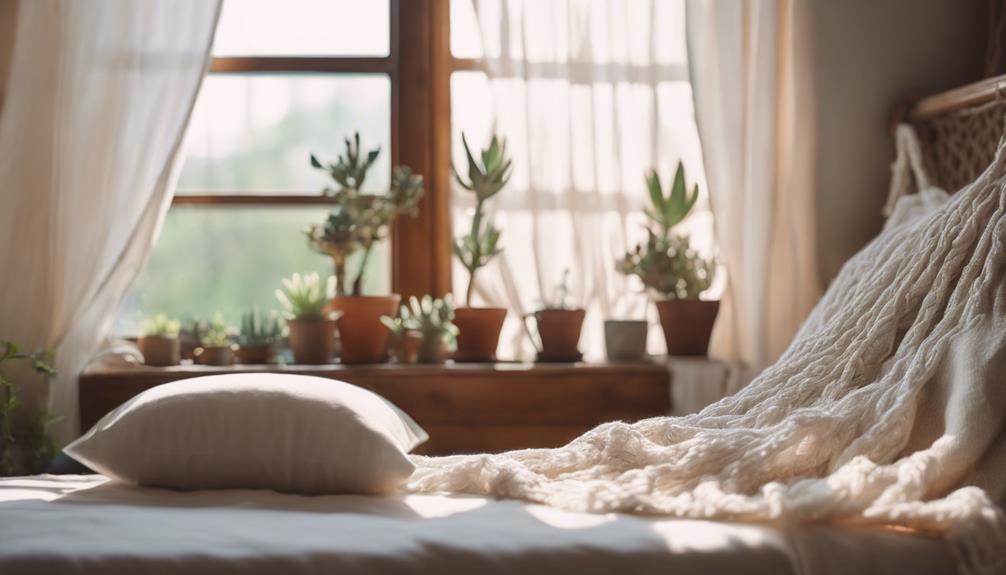
Transforming your bedroom into a late summer retreat can be easy and fun with these creative DIY decor ideas. You can make your space feel like the perfect summer getaway with just a few simple projects.
Start by crafting a custom LED sign using stretch canvas and LED wires. This personalized glow adds a unique touch to your summer bedroom.
Next, explore DIY decor ideas with celestial wall art. Cut out sun, moon, and star shapes from cardboard, paint them, and string lights for a whimsical ambiance.
If you're looking for elegance on a budget, glam up thrifted glass jars and vases by applying gold leaf accents. This will give them an upscale appearance without breaking the bank.
For a chic surface transformation, consider using marble contact paper to create a faux-marble look on your countertops.
Finally, add a playful element by crafting a butterfly mobile from tissue paper butterflies. This colorful decoration showcases your creativity while enhancing the summer vibe in your bedroom.
With these DIY projects, you'll create an inviting and stylish sanctuary for the late summer months ahead.
Utilize Cost-Effective Hacks

Revitalize your bedroom on a budget by incorporating these cost-effective hacks that enhance both style and functionality. You don't need to spend a fortune to create a fresh, inviting space. Here are some simple yet effective ideas to get you started:
- Decorative Contact Paper: Use it to cover old furniture surfaces, giving them a new life without the expense of replacements.
- DIY Headboard: Create a customized headboard using foam board and fabric. It's an affordable way to add a focal point to your room.
Additionally, you can utilize string lights to add a cozy ambiance, perfect for those late summer evenings.
Crafting DIY candle holders from glass jars can also introduce a personal touch to your decor.
These cost-effective hacks not only beautify your bedroom but also make it more functional. Implement these changes today, and watch your space transform into a stylish retreat without breaking the bank! Don’t let the end of summer stop you from updating your bedroom with these late summer decor hacks. By incorporating natural elements like seashells, driftwood, and plants, you can achieve a cozy and relaxing atmosphere that will last well into the fall. With just a few simple changes, you can create a bedroom that reflects your style and personality without spending a fortune.
Layer Textures for Comfort

As summer nights linger, layering different textures in your bedroom can create a cozy and inviting atmosphere that encourages relaxation. Start by mixing cotton coverlets with nubby jute accents; this pairing adds depth and visual interest to your decor.
To enhance the sensory experience, consider incorporating textured curtains alongside smooth bedding. This combination not only looks stylish but also makes the room feel cozier during those warm late summer evenings.
Don't shy away from mixing soft materials, like velvet pillows with woven throws, to create a balanced aesthetic. This juxtaposition promotes a sense of warmth and comfort while ensuring your space remains chic.
Layering your bedding, rugs, and cushions can further enhance that inviting vibe, allowing you to unwind effortlessly.
For a seasonal update, opt for lighter fabrics in your summer bedding. This choice will improve airflow and contribute to a comfortable sleep environment, essential for those warm nights.
Add Summer Scents
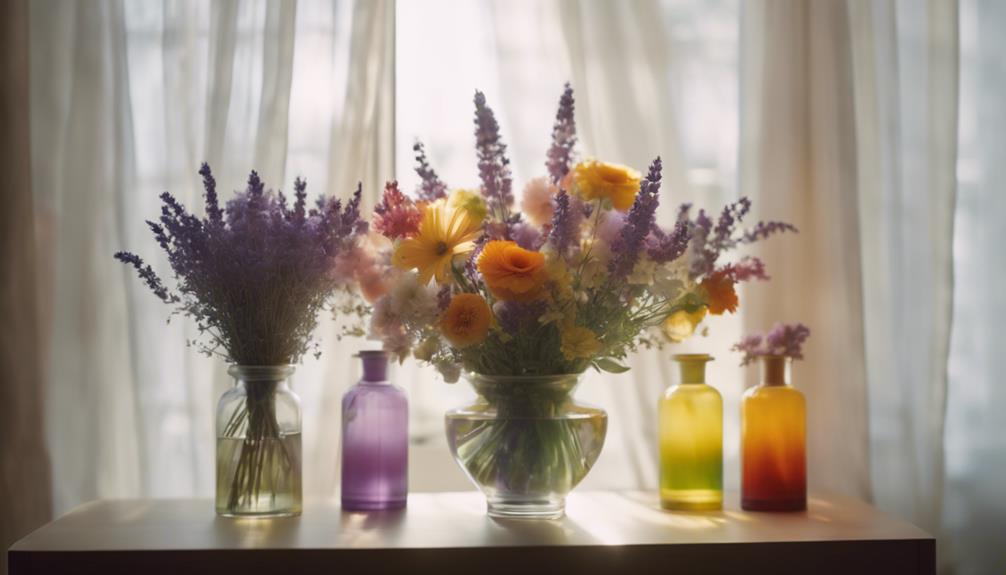
Enhancing your bedroom with summer scents can instantly uplift the space and create a rejuvenating oasis for relaxation. By incorporating fresh aromas, you'll not only feel more at ease but also invite the vibrant energy of summer into your personal sanctuary.
Here are some easy ways to add those delightful summer scents:
- Essential Oil Diffusers: Use lavender, lemon, or eucalyptus to create a revitalizing atmosphere that soothes and invigorates.
- Scented Candles: Choose fragrances like coconut, citrus, or fresh linen to fill your room with warmth and seasonal charm.
Don't forget to place potpourri made from dried flowers and herbs around your room for a subtle yet inviting fragrance. Additionally, opening windows regularly allows fresh air to circulate, complementing your chosen summer scents.
With these simple hacks, you'll transform your bedroom into a fragrant haven, making it the perfect retreat for late summer relaxation.
Conclusion
By embracing these simple hacks, you'll transform your bedroom into a serene summer retreat.
Just when you think your space can't get any better, you'll find that a splash of color or a touch of greenery can spark joy in unexpected ways.
As you layer textures and introduce invigorating scents, you'll be amazed at how these small changes create a big impact.
So go ahead, plunge into this transformation and watch your bedroom bloom into a summer sanctuary!
